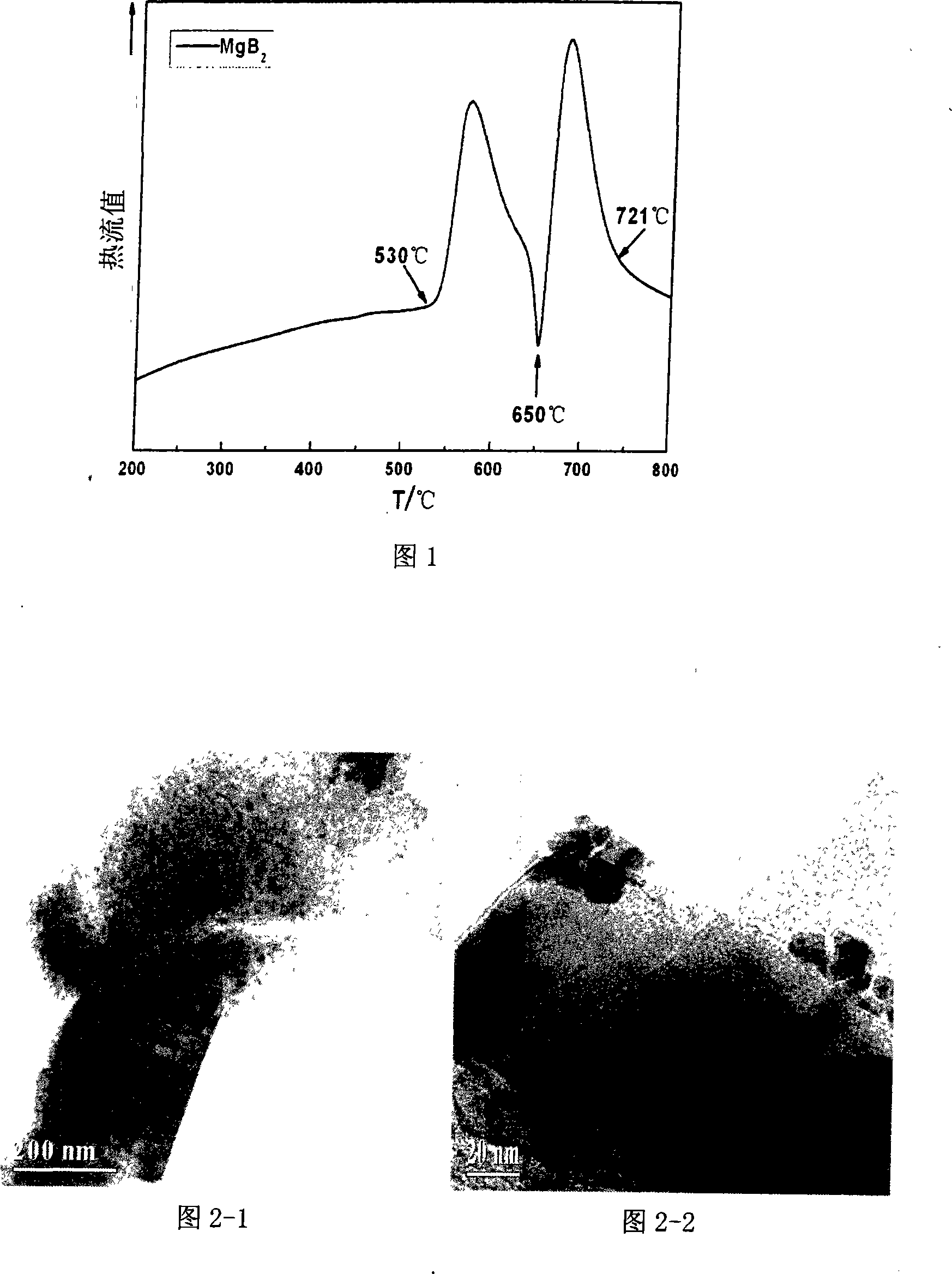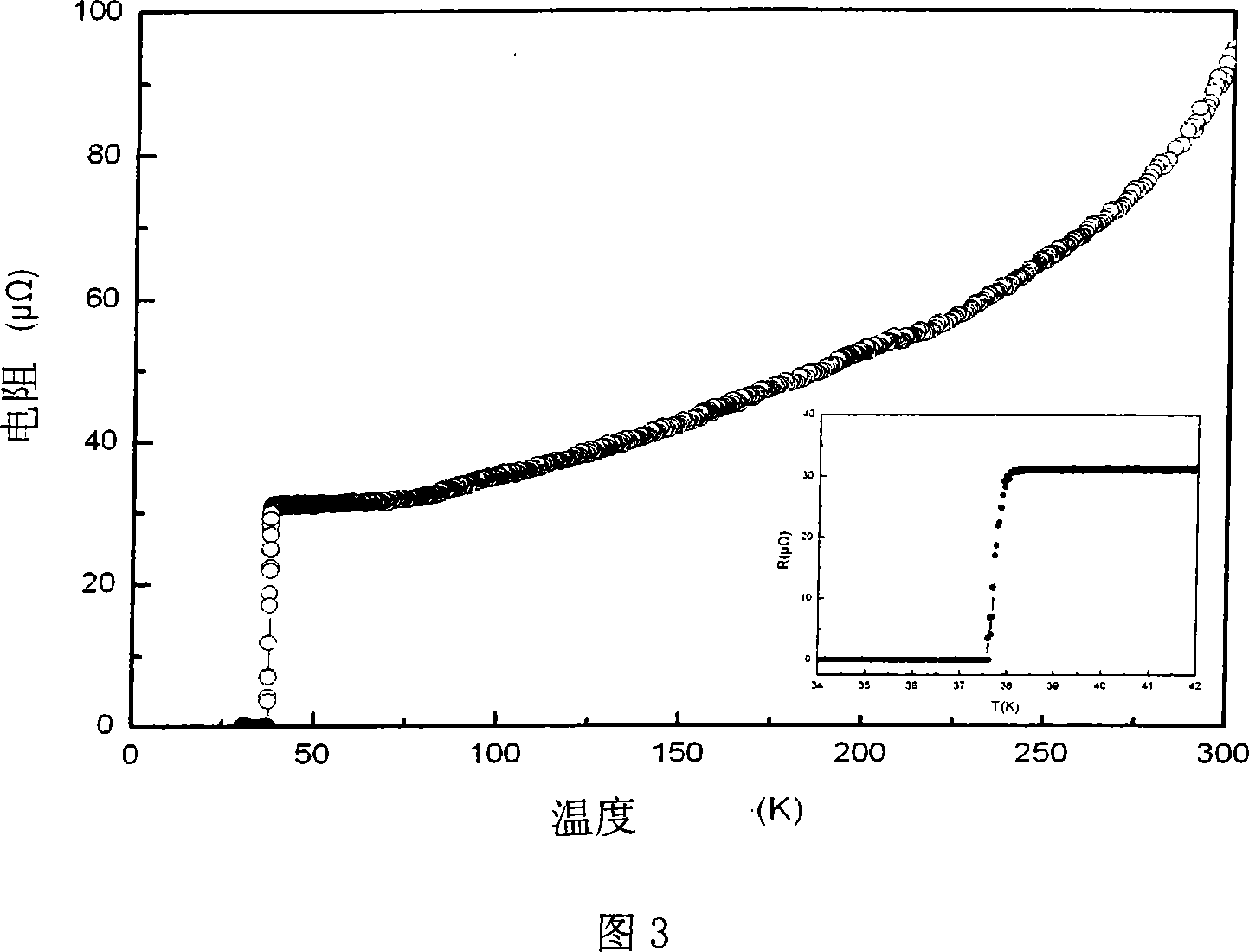Low-temperature fast powder sintering method for superconductive MgB2 nano particle
A technology of nanoparticle and sintering method, which is applied in the field of superconductivity, can solve the problems of time-consuming Mg powder, oxidation, etc., and achieve the effect of uniform particle size, simple preparation method and obvious superconducting characteristics
- Summary
- Abstract
- Description
- Claims
- Application Information
AI Technical Summary
Problems solved by technology
Method used
Image
Examples
Embodiment 1
[0022] A superconducting MgB 2 The low-temperature rapid powder sintering method of nanoparticles is composed of the following steps: magnesium powder (purity 99.5%) and amorphous boron powder (purity 99%) are mixed according to the atomic ratio of Mg: B = 1: 2, and in agate grinding Grind it in a bowl for 1 hour to make it evenly mixed, and then press it under a pressure of 5Mpa to form a cylinder of φ4×2mm, and put the pressed sample into a high-temperature differential scanning calorimeter (NETZSCH DSC 404C Peganus) In the process, argon gas is introduced, and then the temperature program is set as follows: the heating rate is 20K / min, rising to 994K, and directly cooling down to room temperature (25°C) at a cooling rate of 40K / min, that is, a superconducting MgB 2 nanoparticles. Determine the phase composition and crystal morphology in the sample by various detection methods.
Embodiment 2
[0024] A superconducting MgB 2 The low-temperature rapid powder sintering method of nanoparticles is composed of the following steps: magnesium powder (purity 99.5%) and amorphous boron powder (purity 99%) are mixed according to the atomic ratio of Mg: B=1.5: 2, and in agate grinding Grind it in a bowl for 1 hour to make it evenly mixed, and then press it under a pressure of 5Mpa to form a cylinder of φ4×2mm, and put the pressed sample into a high-temperature differential scanning calorimeter (NETZSCH DSC 404C Peganus) In the process, argon is introduced, and then the temperature program is set as follows: the heating rate is 20K / min, rising to 994K, and directly cooling down to room temperature (30°C) at a cooling rate of 40K / min, by changing the atomic ratio of Mg and B. Excess Magnesium Effects on MgB 2 The effect of nanoparticle formation and changes in the growth pattern of nanoparticles in the melt.
Embodiment 3
[0026] A superconducting MgB 2 The low-temperature rapid powder sintering method of nanoparticles is composed of the following steps: magnesium powder (purity 99.5%) and amorphous boron powder (purity 99%) are mixed according to the atomic ratio of Mg: B = 1: 2, and in agate grinding Grind in a bowl for 1 hour to make it evenly mixed, and then press it under a pressure of 5Mpa to form a cylinder of φ4×2mm, and put the pressed sample into a high-temperature differential scanning calorimeter (NETZSCH DSC 404C Peganus) In the middle, argon gas is introduced, and then the temperature program is set as follows: the heating rate is 40K / min, rises to 994K, and directly drops to room temperature (20°C) at a cooling rate of 40K / min, and the speed is observed by changing the heating rate. For MgB 2 Effects of nanoparticle formation and changes in morphology.
PUM
| Property | Measurement | Unit |
|---|---|---|
| diameter | aaaaa | aaaaa |
Abstract
Description
Claims
Application Information
 Login to View More
Login to View More - R&D
- Intellectual Property
- Life Sciences
- Materials
- Tech Scout
- Unparalleled Data Quality
- Higher Quality Content
- 60% Fewer Hallucinations
Browse by: Latest US Patents, China's latest patents, Technical Efficacy Thesaurus, Application Domain, Technology Topic, Popular Technical Reports.
© 2025 PatSnap. All rights reserved.Legal|Privacy policy|Modern Slavery Act Transparency Statement|Sitemap|About US| Contact US: help@patsnap.com


